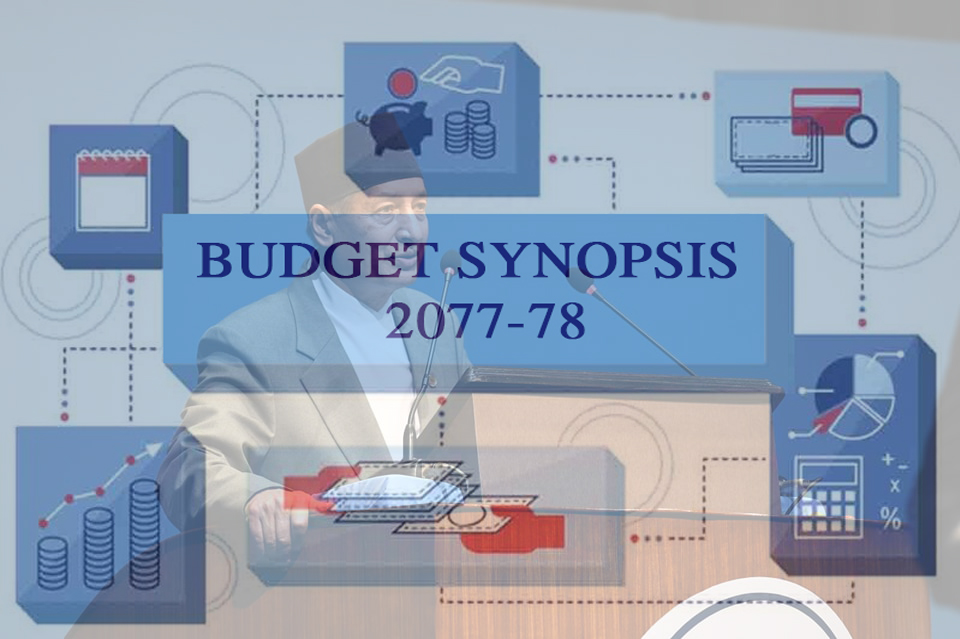Budget Synopsis
On Thursday, 28 May 2020 Honorable Finance Minister, Dr. Yuba Raj Khatiwada presented the full budget for the financial year 2077-78 (2020-21) before combined house. This budget have focus on health and agriculture sectors bit more than previous ones.
The size of the budget for FY 2020-21 is Rs. 1.47 Trillion as compared to Rs. 1.53 Trillion budget in financial year 2019-20.
Due to contraction of overall economy caused by corona virus pandemic, it was expected that the government will bring policies and programs to address the issues that has aroused. But some of the members of the parliament even from the ruling party has questioned the budget efficiency and asked why it failed to break the tradition in the midst of the global pandemic.
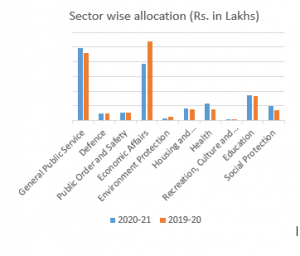
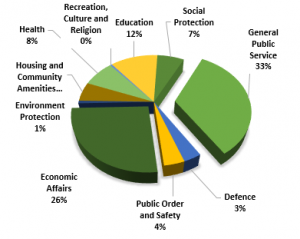
- The government estimated economic growth at unrealistic rate of 7% considering the overall economic slowdown due to corona virus pandemic. It can also be substantiated by 2.5-3% economic growth projected by international agencies like IMF and World Bank.
- Analyzing sector wise distribution, “General Public Service” & “Economic Affairs” covers around two third of the budget. Comparing with previous year budget, we observed significant cut in “Economic Affairs” segment from 35.31% last year to 26.38% current year whereas allocation for “General Public Service” segment has gone up to 33.52% from last year’s 29.95%. its unusual that government instead of focusing on need of the hour to uplift economy, focus is on increasing spending for public service. Other significant gainer includes health sector which is 7.80% compared to 5.11% last year, majorly due to ongoing virus crisis and need for developing the public health infrastructures.
- Fuss has been created as to why the unaccepted MMC grant has also been considered especially when the credibility of the MCC agreement has been questioned even by the members of the ruling party.
Hereunder we have discussed some of the important aspects of what issues budget has addressed and what it has missed.
Sector wise Comment on Budget
1. Health Facilities
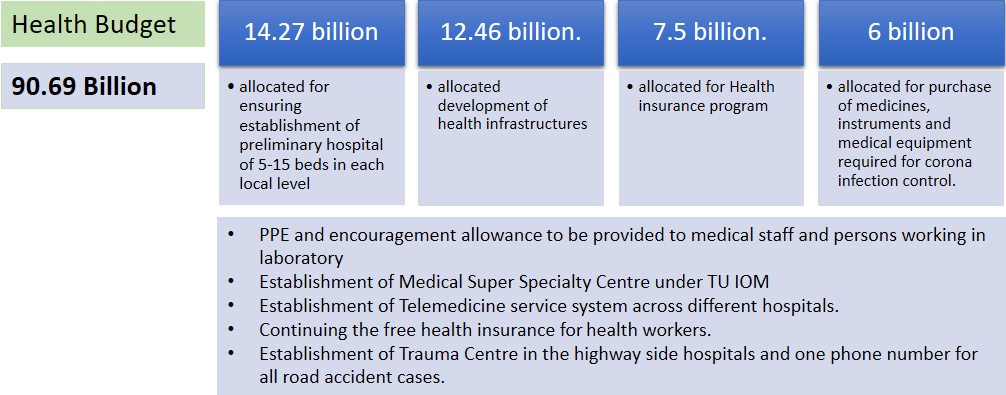
Despite being basic need, the healthcare sector of Nepal has always been overlooked. Ongoing pandemic though has awakened government to realize need of good health facility and compelled to increase the healthcare budget (additional Rs. 20 billion as compared to last year). To fight with corona, budget of 6 billion has been allocated for purchase of medicines, instruments and medical equipment, develop quarantine centers and increasing test. But several specialist has been arguing that it is not enough especially now when the cases are doubling every 4-5 days and increasing number of homecoming nepali workers. Apart from fat amount set aside for combating corona virus pandemic, government budget signifies heavy investment in healthcare infrastructure. Construction of specialized hospitals and hospitals in each local levels is a welcome move. The public health infrastructure in the country is very miserable. So, it gives positive ray of hope if government is able to keep it’s promises. The new and innovative projects like new diagnostic and telemedicine facilities, establishment of medical super specialize center, free health insurance and allowance for encouragement of health workers, etc. are very appreciable aspect of this budget.
2. Agriculture

Most of the people (more than 60% population) in Nepal has been engaged in agriculture, yet agriculture contributes only around 33% of GDP in the economy of Nepal majorly due to use of ancient farming techniques resulting in low productivity. Due to low earnings from agriculture, many creative and passionate youths are compelled to leave the country for better employment opportunities. Adding to it, corona virus pandemic has resulted in homecoming of many such people due to unemployment in foreign countries. This has provided the government with an opportunity to use the dynamism of such youth force in the agriculture sector to make country self-dependent in agriculture. In line with the objective mentioned above, Government has introduced modern concepts of food quality testing, mobile laboratories for soil testing, contract farming, group farming and community co-operative farming, minimum support price, establishment of land banks, farmers credit card and various other subsidies for commercialization, instrumental development and modernization of agriculture and transforming it into job creation which is appreciable in current context. Introduction of food quality laboratory, soil testing laboratory and 200 warehouses around the country is much anticipated and welcome move. Government has planned for really ambitious objectives in agriculture but considering the volume of population that has returned from foreign land, a considerable amount should have been allocated to encourage them but compared to last year budget is not that attractive and thus a certain doubt is created over possibility of achievement of its goals.
3. Infrastructure
3.1. Irrigation Infrastructures

Government has decided to invest heavily in the infrastructure projects and brought the budget with intent to boost them. Since irrigation is the major requirement for agriculture, the boost of both large sized irrigation projects and micro irrigation projects are essential for current situation. Government should now focus on timely completion of all these projects so that reason of existence of these projects be justified. Babai-Bheri Diversion project is one of the most successful and highly praised project of Nepal. Since Nepal has many small rivers from which hydroelectricity cannot be produced efficiently but combining more than one rivers make it efficient. Also, annexing irrigation and drinking water project with it makes it very attractive. Government has prioritized similar Sunkoshi-Marin Diversion project and is planning for feasibility study of other similar projects which will be very handful in future for integrated development.
3.2. Drinking water and Sanitation Infrastructures

Prioritization of government in drinking water and sanitation is another welcome step. Government plans to implement various big projects of drinking water including much awaited Melamchi project. Meanwhile, it is to be noted that small community based drinking water projects are also equally important in the scenario of Nepal where there are very sparse households in upper hilly and mountainous regions.
3.3. Residence, Building & Urban Infrastructure

Government has also set apart sizable amount with a view of integrated urban development and development of auditorium (for which government has been criticized badly in the past). One specific observation is that government has generally focused on Kathmandu valley for housing and urban development programs. Prioritization should also be given to other small cities so that overall country level development can be progressed.
3.4. Energy Infrastructures
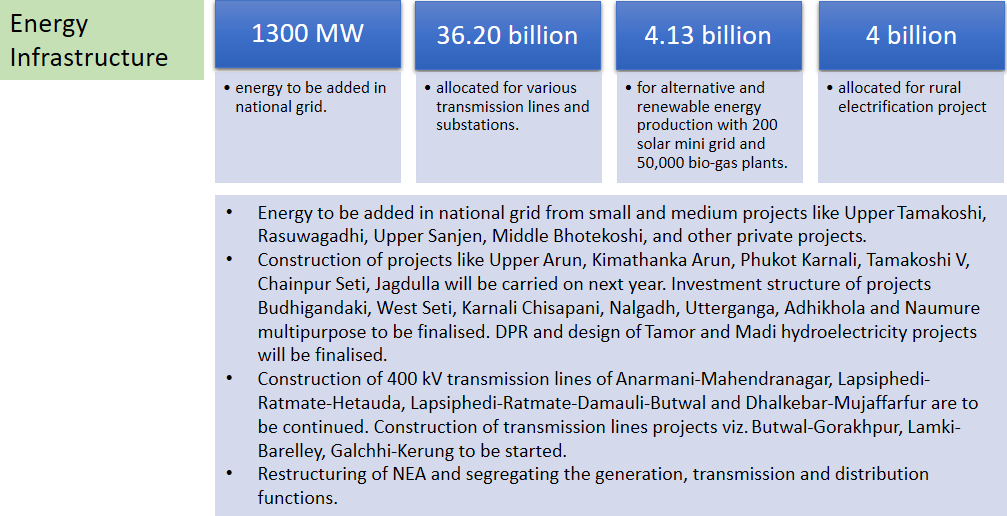
Energy and to be more specific, hydroelectricity, is long being hailed as the tool to uplift the state of Nepalese economy. Nepal has started to invest heavily in the last decade in this sector and the fruits have started showing up. 1300 MW of energy is estimated to be added in national grid and various other big and small hydroelectricity projects are under different phases of development. As stated, Nepal sees possible opportunities to supplement revenue by trading power and for that, a significant investment is being made in cross-border transmission lines and national transmission lines. Rs. 36.20 billion is allocated for development of necessary infrastructure which is quite a significant move. Apart from hydroelectricity, future plan is to invest in other renewable energy and appropriate measures for them has been taken in the form of mini-solar energy projects and bio-gas projects which is appreciable. Rural electrification and undergrounding of distribution networks in major cities can add to city beautification.
3.5. Road Infrastructure, Railway and Water Transport

Government has also started investing in development of east-west railway, integrating it with various western-border entry points and developing railway line upto China entry point as a means to cheaper means of transport and strategically acting as linkage point of Indo-Chinese trade. There is also significant investment in development of bridges and local roads and to fulfil the dream of Prime Minister to have Nepal’s own water transport system. Government has designated highways as per-dominant
factor for overall development and has heavily invested in it which is as expected as these will affect in sustainable development and cost saving in fuel, etc. Ample budget is allocated for highways of strategic importance including East-West highway, Madhya Pahadi Pushpalal Highway, Madan Bhandari Highway, North-South corridors and Kathmandu-Nijgadh Fasttrack.
3.6. Arial Infrastructure, Civil Aviation and Local Infrastructure

Government is seeking alternatives to the only international airport that is currently situated in Kathmandu and developing 3 more international airports at Bhairahawa, Pokhara and Nijgadh. So, it has set aside funds for their development and regular upgradation of existing airports. But several intellectuals have suggested to halt these big projects (except final stage projects) and focus on economic revival. For equitable development and to fulfill the quintessence of federalism, there are allocations for development of local infrastructures like local roads, suspension bridges, rural electrification, agricultural development and capacity enhancement of backward areas of tarai and Himalayan regions.
4. Tourism

Filled with heaps of natural beauty and cultural diversity, Nepal is regarded as one of the blessed landscape for tourism. However, the country has not been quite up to the mark while it comes to converting the potential to opportunity. Year 2020 was designated as “Visit Nepal” year to attract foreign tourists but the plan failed due to coronavirus pandemic. However, no major budget allocation is seen in tourism sector apart from that relief and rebates for the hotel, travel & tourism, trekking and airlines industries which are hit badly by coronavirus pandemic is also not enough for good revival of these sectors of our economy. Encouragement to government and private sector employees for domestic tourism is a low beam of light in otherwise grim budget.
Conclusion :
While looking the budget from overall perspective, it is observed that government has thought of many aspects that it has not considered in earlier budget but it is also clear that government has not made proper assessment of impact and risks the ongoing corona virus pandemic has posed on our small economy. This pandemic is set to have a considerable impact on the economy and government should have planned and prepared to combat the consequences but budget is rather focused on short term rebates and reliefs only. Government could have deferred some infrastructure developments planned so that it can focus upcoming fiscal year revive impacted sector so that our economy does not suffer much.

